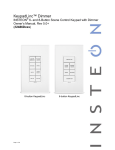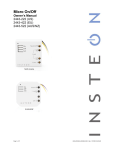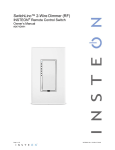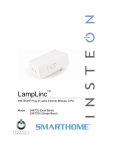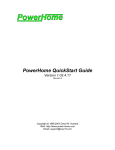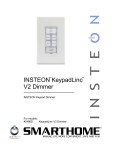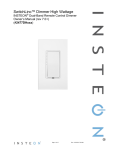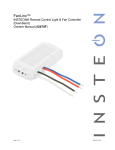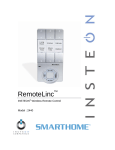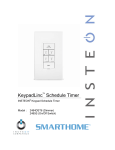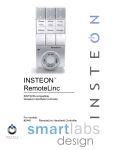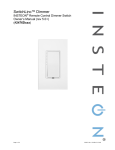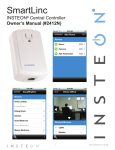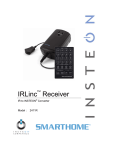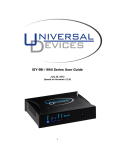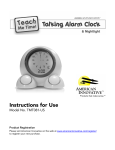Download INSTEON 2478D User's Manual
Transcript
SwitchLinc™ Dimmer INSTEON® Remote Control Dimmer 100 - 277VAC, 50/60Hz Owners Manual (Dual-Band) (#2478D) Shown above with optional custom etching and screwless wallplates (sold separately) Page 1 of 19 2478D - Rev: 1/21/2014 7:32 AM About SwitchLinc 100 - 277VAC 50/60Hz Dimmer ................................................................................... 3 Features & Benefits .................................................................................................................................... 3 What’s in the box? ..................................................................................................................................... 3 Installation ................................................................................................................................................... 4 Identifying the Electrical Wires in your Home ............................................................................................ 4 Tools Needed ............................................................................................................................................ 4 Installing SwitchLinc – with 1 Switch ......................................................................................................... 5 Installation – Circuit with 2 Switches (3-way) ............................................................................................ 6 Installation – Circuit with 3 or more Switches (3-way/4-way) .................................................................... 7 Using SwitchLinc ........................................................................................................................................ 9 LEDs .......................................................................................................................................................... 9 Using the Paddle ....................................................................................................................................... 9 Button Tap / Press & Holds ....................................................................................................................... 9 Local On-Level .......................................................................................................................................... 9 INSTEON Programming ............................................................................................................................ 10 Add SwitchLinc to a Scene as a Responder ........................................................................................... 10 Remove SwitchLinc from a Scene as a Responder ................................................................................ 10 Add SwitchLinc to a Scene as a Controller ............................................................................................. 11 Remove SwitchLinc from a Scene as a Controller .................................................................................. 11 LED Brightness ........................................................................................................................................ 11 Power Restore ......................................................................................................................................... 11 X10 Programming.................................................................................................................................... 12 Advanced Features ................................................................................................................................... 12 Add Multiple Scene Responders (formerly “Multi-Linking Mode”) ........................................................... 12 Remove Multiple Scene Responders (formerly “Multi-Unlinking Mode”) ................................................ 12 Synchronized Scenes formerly “Cross-Linking” (2 switches; 3-way) (3 or more; 3-way/4-way) ............. 12 Air Gap..................................................................................................................................................... 13 Factory Reset .......................................................................................................................................... 13 Change Paddle and LED Colors ............................................................................................................. 14 Local Ramp Rate (software recommended)............................................................................................ 14 Additional Resources ............................................................................................................................... 15 Optional Accessories ............................................................................................................................... 15 Beeper Behavior ........................................................................................................................................ 15 Blink LED on INSTEON Traffic ................................................................................................................ 15 Air Gap..................................................................................................................................................... 15 Factory Reset .......................................................................................................................................... 15 Specifications ............................................................................................................................................ 16 Troubleshooting ........................................................................................................................................ 17 Certification and Warranty ....................................................................................................................... 19 Certification .............................................................................................................................................. 19 FCC & Industry Canada Compliance Statement ..................................................................................... 19 ETL / UL Warning (Safety Warning) ........................................................................................................ 19 Limited Warranty ..................................................................................................................................... 19 Page 2 of 19 2478D - Rev: 1/21/2014 7:32 AM About SwitchLinc 100 - 277VAC 50/60Hz Dimmer Congratulations on purchasing the SwitchLinc Dimmer. This version of the popular SwitchLinc line of dimmers offers automatic 50/60Hz detection of the AC power frequency and flexible 100 - 277VAC support allowing operation in a variety of electrical environments. Features & Benefits • • • • • • • • • • • • • • • After installation, setup is easy – Add to Scenes with other INSTEON devices in minutes International-friendly 50/60Hz auto-detect and flexible 100 - 277VAC power support Controls all standard incandescent lamps, up to 600 watts Adjustable to 32 dim levels Adjustable on/off Ramp Rate speeds Paddle has true rocker action – top is on or bright, bottom is off or dim 9-level LED bar shows brightness of lights Status LED and beeper indicates INSTEON setup mode activity Status LED provides gentle nightlight when switch is off White LED bar color is changeable to green, blue, amber or red with optional kit Responds to commands from X10 controllers and sends X10 commands to X10 devices Wires in like a standard wall switch (but also requires a Neutral connection) Supports SwitchLinc "virtual" 3-way, 4-way circuits White paddle and trim frame is changeable to ivory, almond, black, brown or gray with optional kit Two-year warranty LED Bar Brightness Indicator Paddle top (On/Bright) Paddle Bottom (Off/Dim) Trim Frame Wallplate (sold separately) Set Button (push) Air Gap (pull) What’s in the box? • • SwitchLinc Dimmer Four wire nuts Page 3 of 19 2478D - Rev: 1/21/2014 7:32 AM • Quick-Start Guide Installation CAUTIONS AND WARNINGS Read and understand these instructions before installing and retain them for future reference. This product is intended for installation in accordance with the National Electric Code and local regulations in the United States or the Canadian Electrical Code and local regulations in Canada. Use indoors only. This product is not designed or approved for use on power lines other than single-phase voltages between 100 – 277VAC, 50/60Hz., single phase. Attempting to use this product on non-approved power lines may have hazardous consequences. Recommended installation practices: • Use only indoors or in an outdoor rated box • Be sure that you have turned off the circuit breaker or removed the fuse for the circuit you are installing this product into. Installing this product with the power on will expose you to dangerous voltages. • Connect using only copper or copper-clad wire • This product may feel warm during operation. The amount of heat generated is within approved limits and poses no hazards. To minimize heat buildup, ensure the area surrounding the rear of this product is as clear of clutter as possible. • To reduce the risk of overheating and possible damage to other equipment, do not use this product to control Loads in excess of the specified maximum(s) or, install in locations with electricity specifications which are outside of the product’s specifications. If this device supports dimming, please note that dimming an inductive Load, such as a fan or transformer, could cause damage to the dimmer, the load bearing device, or both. If the manufacturer of the load device does not recommend dimming, use a non-dimming INSTEON on/off switch. USER ASSUMES ALL RISKS ASSOCIATED WITH DIMMING AN INDUCTIVE LOAD. Identifying the Electrical Wires in your Home • • • • Line - usually Black, may also be called HOT, LIVE or Power, carries 100 - 277VAC electricity into the wall box Neutral - usually White commonly daisy chained from box to box usually appearing as a White wire bundle Load – usually Black, Blue, or Red (from a separate cable jacket) Ground - Bare wire or metal fixture (if grounded) IMPORTANT! • Each INSTEON product is assigned a unique INSTEON ID, which is printed on the product’s label. Please take note for future reference • If you have any difficulties or questions, consult an electrician. If you are not knowledgeable about, and comfortable with electrical circuitry, you should have a qualified electrician install the product for you. Tools Needed • • Slotted screwdriver Wire cutter / stripper • • Phillips screwdriver Voltage Meter Page 4 of 19 2478D - Rev: 1/21/2014 7:32 AM Installing SwitchLinc – with 1 Switch 1) 2) 3) 4) 5) 6) 7) 8) 9) 10) 11) 12) 13) Turn off circuit breaker(s) or remove fuse(s) feeding wall box Use a voltage meter to verify that power is off Remove wallplate from the switch and unscrew switch you are replacing and gently pull out 1 Disconnect wires from switch SwitchLinc Wire Wall Box Wires Turn breaker(s) back on Ground Use a voltage meter to identify Line and Load (commonly Bare, wires which connected to the switch Bare copper Green wire or Green Identify Neutral and Ground wires screw) Turn breakers(s) back off Neutral Connect wires as per Table A/Fig. 1(confirm firm White (commonly White) attachment with no exposed wire) Load Gently place SwitchLinc into wall box, orienting Red (Light, commonly unit with the LED bar on left. Then, screw Black) SwitchLinc into place. Line (100 – 277V to Turn breaker(s) back on Black Ground) SwitchLinc’s LED bar and connected light will turn on Verify SwitchLinc is working properly by tapping SwitchLinc’s paddle turning light (load) on and Table off A Reinstall the wallplate Fig 1 1 If the wires cannot be detached by unscrewing them, cut the wires where they enter the switch, then strip ½” of insulation off the ends Page 5 of 19 2478D - Rev: 1/21/2014 7:32 AM Installation – Circuit with 2 Switches (3-way) Circuits with 2 switches are called 3-way circuits. Both switches in a 3-way circuit need to be replaced by SwitchLincs (and/or KeypadLincs). Note: 3-way circuits require a pair of wires called Travelers between joining wall boxes to operate. INSTEON switches, dimmers and keypads do not require both Traveler wires for 3-way circuits to function. Simply wire one to Line, Neutral and Load; the other(s) to Line and Neutral. Use one Traveler to share Line between boxes. Adding both SwitchLincs to a Scene creates a virtual 3-way circuit. 1) 2) 3) 4) 5) 6) Turn off circuit breaker(s) and/or remove fuse(s) feeding wall boxes Use a voltage meter to verify that power is off Pull both switches from their wall boxes, each existing 3-way switch will have no less than 3 wires Remove wires from existing switches Make sure wires are safely separated from each other and turn breaker(s) back on Using a voltage meter measure each wire to Ground in both boxes until you find the single wire supplying 100 - 277VAC (Line) a. We will now refer to that location as box 1 b. The other box will have the Load wire. That will be box 2 7) Turn breaker(s) back off In Box 1 (Line box) 8) Connect bare Ground wire from the SwitchLinc to bare Ground wire or Ground screw in wall box 9) Connect White Neutral wire from SwitchLinc to Neutral wire(s) in wall box (usually white) 10) Using a wire nut, cap the Red wire from SwitchLinc 11) Connect Black wire from Switch Linc to 100 277VAC Line wire in wall box (usually Black) along with one Traveler wire running between boxes (preferably Black). Note color of Traveler you are using as this will carry Line voltage to box 2. 12) Cap unused Traveler In Box 2 (Load box) 13) Connect bare Ground wire from SwitchLinc to bare Ground wire or Ground screw in wall box 14) Connect White Neutral wire from SwitchLinc to Neutral wire(s) in wall box (usually White) 15) Connect Red wire from SwitchLinc to Load wire (usually Black) 16) Connect Black wire from SwitchLinc to same color Traveler from box 1 carrying 100 - 277VAC Line (usually Black) 17) Cap unused Traveler wire 18) With the LED bar on the left, gently place both SwitchLincs into the junction boxes and screw in place 19) Turn breaker(s) On Page 6 of 19 2478D - Rev: 1/21/2014 7:32 AM SwitchLinc’s LED bar and connected light will turn on Only SwitchLinc in box 2 will operate the Load until you synchronize Scenes to both SwitchLincs in next step 20) Add both SwitchLincs to a Scene as a Controller and Responder of each other (see Synchronized Scenes) 21) Verify SwitchLinc(s) are working properly by tapping SwitchLinc’s paddle turning light (load) on and off 22) Reinstall wallplates Installation – Circuit with 3 or more Switches (3-way/4-way) Circuits with 3 or more switches are called 3-way/4-way circuits. All switches in 3-way/4-way circuits need to be replaced by SwitchLincs (and/or KeypadLincs). Note: 3-way/4-way circuits require a pair of wires called Travelers between joining wall boxes to operate. INSTEON switches, dimmers and keypads do not require both Traveler wires for 3-way/4-way circuits to function. Simply wire one to Line, Neutral and Load; the other(s) to Line and Neutral. Use one Traveler to share Line between boxes. Adding to a Scene creates a virtual 3-way/4-way circuit. The following example shows three switches 1) Turn off circuit breaker(s) and/or remove fuse(s) feeding wall boxes 2) Use a voltage meter to verify that power is off 3) Pull all three switches from their wall boxes, each existing 3-way switch will have a minimum 3 wires; 4-way switches will have a minimum 4 wires 4) Remove wires from existing switches 5) Make sure wires are safely separated from each other and turn breaker(s) back on 6) Using a voltage meter measure each wire to Ground in all three boxes until you find the single wire supplying 100 - 277VAC (Line) a. We will now refer to that location as box 1 b. The location having 2 sets of matching pairs of wires will be box 2 (e.g. 2 Reds and 2 Blacks, or other matching colors). These are 2 Travelers from box 1 and 2 Travelers leading to box 3. c. The last box will have the Load wire, that will be box 3 7) Turn breaker(s) back off In Box 1 (Line box) 8) Connect bare Ground wire from SwitchLinc to bare Ground wire or Ground screw in the wall box 9) Connect White Neutral wire from SwitchLinc to Neutral wire(s) in wall box (usually white) 10) Cap Red wire from SwitchLinc 11) Connect Black wire from SwitchLinc to 100 - 277VAC Line wire in wall box (usually Black) along with one Traveler wire running between boxes (preferably Black). Note color of Traveler you are using as this will carry Line voltage to box 2. 12) Cap unused Traveler wire In Box 2 (Traveler box) Page 7 of 19 2478D - Rev: 1/21/2014 7:32 AM 13) 14) 15) 16) Connect bare Ground wire from SwitchLinc to bare Ground wire or Ground screw in the wall box 1 Connect White Neutral wire from SwitchLinc to Neutral wire(s) in wall box (usually White) Cap Red wire from the SwitchLinc Connect the Black wire from SwitchLinc to same color Traveler from box 1 that you connected to 100 - 277VAC Line along with the same color Traveler wires leading to box 3 17) Cap the last unused Traveler wire(s) In Box 3 (Load box) 18) Connect bare Ground wire from SwitchLinc to bare Ground wire or Ground screw in wall box 19) Connect White Neutral wire from SwitchLinc to Neutral wire(s) in wall box (usually White) 20) Connect Red wire from SwitchLinc to Load wire (usually Black) 21) Connect Black wire from SwitchLinc to the 100 - 277VAC Line Traveler from box 2 (Line Traveled from box 1 through 2 into 3, usually Black) 22) Cap unused Traveler wire 23) With the LED bar on the left, gently place both SwitchLincs into the junction boxes and screw in place 24) Turn breaker(s) On SwitchLincs' LED bar and connected light will turn on Only SwitchLinc in box 3 will operate the Load until you synchronize Scenes on all 3 SwitchLincs in next step 25) Add each SwitchLinc to a Scene as a Controller and Responder of each other (see Synchronized Scenes) 26) Verify SwitchLincs are working by turning the light on and off from all three SwitchLincs 27) Reinstall wallplates 1 If Neutral is not available in this box; use other unused Traveler from box 1 to carry Neutral to box 2. Label and mark any differently colored wire being connected to Neutral with a piece of white tape to flag it as Neutral. Page 8 of 19 2478D - Rev: 1/21/2014 7:32 AM Using SwitchLinc LEDs • • LED Status Meaning Bottom LED of Brightness Bar On SwitchLinc powered up load off LEDs on Brightness Bar On Level of load brightness load on On LED Off LED On LED (White) o Illuminated when SwitchLinc is On Off LED (White) o Illuminated when SwitchLinc is Off Using the Paddle Paddle Top Tap Double-tap Press & hold begin Press & hold end Turn On Connected load quickly comes On to full bright & Scene Responders Connected load gradually brightens & start brightening Scene Responders Connected load & Scene Responders stop brightening Connected load quickly turns Off & Scene Responders Connected load gradually dims & Start dimming Scene Responders Connected load & Scene Responders stops dimming Connected load ramps to set brightness & Scene Responders Turn Off Bottom • • • • • • Connected load ramps to full Off & Scene Responders Tap paddle top to make load turn on at local ramp rate, from present brightness to local On-level brightness Tap paddle bottom to make load turn off at local ramp rate, from present brightness to full Off Double-tap paddle top to make load go full On quickly Double-tap paddle bottom to make load go full Off quickly Press & hold paddle top to gradually brighten load from present brightness to full On Press & hold paddle bottom to gradually dim load from present brightness to full Off Button Tap / Press & Holds Paddle Tap Double-Tap Press & Hold Top Ramp to On-Level Fast On Brighten Bottom Ramp to Off Fast Off Dim Local On-Level The Local On-Level is the brightness that the light(s) physically wired to SwitchLinc will come on at when turned on locally. The On-Level is adjustable from off to 100% brightness. The default is 100%. 1) Use either the local buttons on your dimmer module or an INSTEON Controller to adjust the light to the desired brightness a. Press & hold the On button on the dimmer or Controller to brighten the light. Release at the desired brightness. b. Press & hold the Off button on the dimmer or Controller to dim the light. Release at the desired brightness. Page 9 of 19 2478D - Rev: 1/21/2014 7:32 AM 2) Once the desired brightness has been achieved, tap the Set button on your dimmer once SwitchLinc will (Beep) a. The local On-Level has now been set. If you would like to set up a Controller to set your dimmer to the above On-Level as well, proceed to step 3. b. If you do not wish to set up the On-Level to an INSTEON Controller, skip to step 4. 3) Choose the desired button on your INSTEON Controller and Add a Scene to your dimmer (see the Controller's Owner's Manual for Add a Scene instructions) 4) Test the On-Level settings by pressing the On/Off buttons on your dimmer and Controller you just Added a Scene to NOTE: If the dimmer module is blinking its Status LED, you held the Set button down too long. Holding down the Set button for 3 seconds is an alternate way to place the INSTEON dimmer into Scene Mode. Scene Mode will time out after 4 minutes of inactivity. To manually exit Scene Mode, tap top or bottom paddle. INSTEON Programming INSTEON remote control is done using Scenes. Scenes allow you to instantly “recall” favorite lighting and appliance settings at the touch of a button (or in response to central control or even a sensor). Each Scene has at least one Controller and at least one Responder. Simple Scenes can be setup using the instructions below. Software is recommended for setup of larger Scenes. Add SwitchLinc to a Scene as a Responder 1 1) Press & hold Scene Controller button until it beeps Controller’s LED will blink 2) Tap SwitchLinc On Load will turn on 3) Press & hold SwitchLinc’s Set button until it double-beeps SwitchLinc will (Beep)-(Beep) 2 Controller’s LED will stop blinking and it will (Beep)-(Beep) 4) Confirm Scene addition was successful by tapping On then Off on Controller’s Scene button SwitchLinc will respond appropriately Remove SwitchLinc from a Scene as a Responder If you want to remove SwitchLinc from a Scene(s) as a Responder follow instructions below. Whenever possible, use software for managing Scene memberships. Note: If you choose to remove SwitchLinc from use, it is important that you remove Scene memberships from all Controllers. Otherwise, Controllers will retry commands repetitively, creating network delays. Follow the instructions below for each Scene Controller that SwitchLinc is a member of. 3 1) Press & hold Controller’s Scene button until Controller beeps Controller’s LED will blink 2) Press & hold Scene button until Controller beeps again Controller’s LED will continue blinking 3) Tap SwitchLinc On Load will turn on 4) Press & hold Set button on SwitchLinc until it double-beeps SwitchLinc’s LED will flash once Controller’s LED stops blinking 5) Confirm Scene removal was successful by tapping Controller button with the Scene you just removed SwitchLinc will no longer respond 1 2 3 If the Controller does not have a beeper, wait until its LED begins blinking Most models For devices without beepers hold until its LED begins blinking (this may take 10+ seconds) Page 10 of 19 2478D - Rev: 1/21/2014 7:32 AM Add SwitchLinc to a Scene as a Controller Follow the steps below to control a Scene (one or more INSTEON devices) from a SwitchLinc paddle 1) 2) 3) 5) 6) Press & hold SwitchLinc’s Set button until it beeps SwitchLinc’s LED will blink Adjust the Scene Responder(s) to the “state” you want when Scene is activated from SwitchLinc 1 (e.g., 50%, 25% or even OFF) Press & hold Responder’s Set button until it double-beeps (or until its LED/Load flashes) 2 SwitchLinc will (Beep)-(Beep) and its LED will stop blinking 3 Responder’s LED will stop blinking and it may (Beep)-(Beep) Confirm Scene addition was successful by tapping SwitchLinc’s paddle on and off Responder will toggle between the Scene’s on level and off If you wish to add more Responders to the Scene, repeat steps 1-5 for each additional Scene Responder or (see Add Multiple Scene Responders) Remove SwitchLinc from a Scene as a Controller If you want to remove SwitchLinc from a Scene(s) as a Controller follow instructions below. Whenever possible, use software for managing Scene memberships. Note: If you choose to remove SwitchLinc from use, it is important that you remove Scene memberships from all Responders. Follow the instructions below for each Responder that SwitchLinc is a member of. 1) Press & hold SwitchLinc’s Set button until it beeps SwitchLinc’s LED will blink 2) Press & hold SwitchLinc’s Set button until it beeps again SwitchLinc’s LED will begin blinking 3) Press & hold Responder’s Set button until it double-beeps (or LED blinks) SwitchLinc will (Beep)-(Beep) and its LED will stop blinking 4) Confirm that Scene removal was successful by tapping SwitchLinc’s paddle on and off Responder will not respond 5) If you wish to remove multiple Responders from SwitchLinc, repeat steps 1-5 for each additional Responder or (see Remove Multiple Scene Responders) LED Brightness 1) 2) 3) 4) 5) Press & hold SwitchLinc’s Set button until it beeps (3 seconds) SwitchLinc’s LED will begin blinking Press & hold Set button until it beeps again (3 seconds) SwitchLinc’s LED will continue blinking Press & hold Set button until it beeps a third time (3 seconds) SwitchLinc’s LED will stop blinking SwitchLinc’s Status LED will illuminate at current LED brightness level Use the paddle to brighten or dim the LEDs to desired brightness a. Press & hold paddle top to brighten b. Press & hold paddle bottom to dim (fully OFF for dimmest) Once you have reached the desired brightness for your LEDs, tap Set button once SwitchLinc will beep LED’s now set to new brightness level Power Restore SwitchLinc stores all of its Scenes, properties, etc. in non-volatile memory. As such, all settings are retained after a power outage. Upon power being restored, SwitchLinc will return its connected load and all LEDs to their states prior to power outage. 1 2 3 If the Responder is a multi-Scene device such as a KeypadLinc, tap the Scene button you wish to control until its LED is in the desired Scene state (on or off) If either the SwitchLinc or Responders LED continues to blink, the addition failed. Tap the device’s Set button until LED stops blinking and try again. If either the SwitchLinc or Responders LED continues to blink, the addition failed. Tap the device’s Set button until LED stops blinking and try again. Page 11 of 19 2478D - Rev: 1/21/2014 7:32 AM X10 Programming Instructions on setting X10 primary address and Scene addresses can be found online: http://www.smarthome.com/insteon-x10-programming.html Advanced Features Add Multiple Scene Responders (formerly “Multi-Linking Mode”) 1) Press & hold SwitchLinc’s Set Button until it beeps SwitchLinc’s LED will blink 2) Tap SwitchLinc’s Set Button LED will continue blinking 3) For each Responder you are adding a. Adjust the Responder to desired Scene state b. Press & hold Responder’s Set button until it beeps (or LED flashes) SwitchLinc will (Beep)-(Beep) 4) After all Responders have been added, tap SwitchLinc’s Set Button SwitchLinc’s LED will stop blinking 5) Confirm Scene addition was successful by tapping SwitchLinc’s paddle on and off Responder will toggle between the Scene’s on level and off Remove Multiple Scene Responders (formerly “Multi-Unlinking Mode”) 1) Press & hold SwitchLinc’s Set Button until it beeps Switchlinc’s LED will blink 2) Press & hold SwitchLinc’s Set Button again until it beeps again LED will continue blinking 3) Tap SwitchLinc’s Set Button LED will continue blinking 4) For each Responder you are removing a. Tap Scene button b. Press & hold Responder’s Set button until it beeps (or LED flashes) 5) After all Responders have been removed, Tap SwitchLinc’s Set Button SwitchLinc’s LED will stop blinking 6) Confirm Scene removal was successful by tapping SwitchLinc’s paddle on and off All the Responders removed will not respond Synchronized Scenes formerly “Cross-Linking” (2 switches; 3-way) (3 or more; 3-way/4-way) Synchronized Scenes are Scenes where all members stay synchronized. Common examples include 3way lighting circuits and Scenes with a single Load bearing device. Synchronize Scenes with 2 SwitchLincs and identify them as A and B 1) Turn both switches/dimmers on – to the desired (and same) Scene level 2) Press & hold Switch A’s Set button until it beeps (or LED blinks) Switch A’s LED will blink 3) Press & hold Switch B’s Set button until it double-beeps (or LED flashes) Switch B will (Beep)-(Beep) and its LED will flash once Switch A will (Beep)-(Beep) and its LED will stop blinking 4) Press & hold Switch B’s Set button until it beeps (or LED blinks) Switch B’s LED will blink 5) Press & hold Switch A’s Set button until it double-beeps (or LED flashes) Switch A will (Beep)-(Beep) and its LED will flash once Switch B will (Beep)-(Beep) and its LED will stop blinking 6) Test the group by controlling the Load from Switch A and then Switch B The Load, Switch A’s status LED(s) and Switch B’s status LED(s) will all remain in synch Page 12 of 19 2478D - Rev: 1/21/2014 7:32 AM Synchronized Scene with 4 members (3-way/4-way) Software is recommended, however, the following steps, when carefully followed, will also work. For our example we will Synchronize SwitchLincs and identify them as switches A, B, C and D. 1) Turn all switches on – to the desired (and same) Scene level a. Press & hold Switch A’s Set button until it beeps (or LED blinks) Switch A’s LED will blink b. Tap Switch A’s Set button Switch A’s LED will continue blinking c. For switches B, C and D, press & hold the Set button on each, one at a time, until it double-beeps (or LED flashes) Switch B, C and D will (Beep)-(Beep) and its LED will flash once d. Tap Switch A’s Set button Switches B, C, and D are now Responders of and Synchronized to switch A’s setting as a Scene Controller 2) Return to Step 1 above, turn all switches on – to the desired (and same) Scene level 3) Follow steps a. and b. above substituting with switch B to start Synchronized Scenes 4) Follow step c. for switches A, C and D 5) Follow step d. above substituting with switch B to end program 6) 7) 8) 9) Return to Step 1 above, turn all switches on – to the desired (and same) Scene level Follow steps a. and b. above substituting with switch C to start Synchronized Scenes Follow step c. for switches A, B and D Follow step d. above substituting with switch C to end program 10) 11) 12) 13) Return to Step 1 above, turn all switches on – to the desired (and same) Scene level Follow steps a. and b. above substituting with switch D to start Synchronized Scenes Follow step c. for switches A, B and C Follow step d. above substituting with switch D to end program All 4 switches are now set as Scene Controllers and each of the remaining switches in the group are Synchronized as Responders Air Gap To remove all power from SwitchLinc and connected light(s), pull the Set button at the bottom of the switch out as far as it will go, about 1/8”. (It might be helpful to use a small screwdriver.) This will open mechanical contacts creating an Air Gap. To restore power, tap the air gap back into place, until its top is even with the trim frame. Note: If you press Set button in too far, you might inadvertently reset the INSTEON device to its factory default settings. Make sure to only push the Set button down so that it is flush with trim frame. Factory Reset Factory Reset clears all user settings from SwitchLinc including INSTEON Scenes, On-Levels, Ramp Rates, X10 addresses, etc. 1) Pull Set button out (creating an Air Gap) 2) Wait 10 Seconds 3) Press the Set Button in as far as you can & hold SwitchLinc will (Beep) 4) Release the Set button Device’s embedded software will re-write all settings to factory defaults A couple of seconds will pass SwitchLinc will (Beep)-(Beep) LEDs will return to normal brightness SwitchLinc returns to Ready Mode Connected load will turn on Page 13 of 19 2478D - Rev: 1/21/2014 7:32 AM Change Paddle and LED Colors You can swap out the included white LEDs and/or front paddle and trim frame assembly with a colorchange kit before or after SwitchLinc is installed. For more information, see the Accessories page on INSTEON.com. Local Ramp Rate (software recommended) 1 Setting the Ramp Rate Local Ramp Rate is the time it takes for SwitchLinc(s) to go from Off to 100% brightness The default is 0.5 seconds Local-Ramp-Rate is adjustable from 0.1 seconds to 8 minutes (0.1- 9 seconds using the instructions below or up to 8 minutes using software NOTE: Setting the Ramp Rate does not change/affect the On-Level brightness. Setting Ramp Rate is done using brightness level as an indicator for how fast SwitchLinc should ramp. a. Use the Up / Down paddle on SwitchLinc to set brightness • Set Brighter level for a faster Ramp Rate o 100% corresponds to a 0.1-second Ramp Rate (fast Ramp Rate) • Set Dimmer for a slower Ramp Rate o Full-off corresponds to a 9-second Ramp Rate (slow Ramp Rate) The following table gives the approximate relationship between the brightness you set in this step and the Ramp Rate you get. Brightness Ramp Rate 1) Adjust the connected light(s) to brightness corresponding to desired Level Ramp Rate .25 Seconds 2) Double-tap Set button on your SwitchLinc Full Bright (Fast) SwitchLinc will (Beep) 3) Test Ramp Rate settings by tapping On/Off paddle on your SwitchLinc or Controller Various levels Connected light(s) will ramp up and down at the new rate between 4) Start again if the ramp rate is not as desired or, if your double tap was not fast enough you may have accidentally changed the Local OnLevel instead of the Local Ramp Rate 2 Seconds Half Bright (Med) Note: a. Software allows you to set on-levels and Ramp Rates exactly as desired and consistently around the house Various levels b. Ramp Rates can be extended up to 8 minutes via home between automation software Full Off 1 9 Seconds (Slow) Setting the Ramp Rate does not change or affect the on-level brightness Page 14 of 19 2478D - Rev: 1/21/2014 7:32 AM Additional Resources Find home automation solutions, helpful tips, interactive demos, videos, user forums, and more at the Smarthome Learning Center: www.smarthome.com/learningcenter.html Optional Accessories Paddle Color Change Kit http://www.smarthome.com/_/SwitchLinc/SwitchLinc_Paddle_Change_ Kits/_/2vh/2wL/nav.aspx LED Color Change Kit http://www.smarthome.com/_/SwitchLinc/SwitchLinc_LED_Change_Kits /_/2vh/2wN/nav.aspx Custom Etched Paddles http://www.smarthome.com/_/SwitchLinc/SwitchLinc_Custom_Etching/_ /2vh/2wP/nav.aspx Beeper Behavior The SwitchLinc features a built-in beeper which aids in programming and can also be used as an indicator via compatible software controllers. Here are the different beeping behaviors and what they mean: • Single Beep: Transition from one setup mode to another • Double Beep: Successful Scene addition or removal • Continuous beeps for 3 seconds: Unsuccessful Scene management or 4 minute setup timeout Blink LED on INSTEON Traffic This feature can be enabled (and subsequently disabled) via compatible software packages. Air Gap To remove all power from SwitchLinc and connected light(s), pull the Set button at the bottom of the switch out as far as it will go, about 1/8”. (It might be helpful to use a small screwdriver.) This will open mechanical contacts creating an Air Gap. To restore power, tap the air gap back into place, until its top is even with the trim frame. Note: If you press the Set button in and hold it down for more than 3 seconds, you might inadvertently start the reset routine (see below). Make sure to only push Set button down so that it is flush with the trim frame. Factory Reset Factory Reset clears all user settings from SwitchLinc including INSTEON Scenes, On-Levels, Ramp Rates, X10 addresses, etc. 1) 2) 3) 4) If possible, remove all scene memberships prior to performing the factory reset Pull Air Gap out Wait 10 seconds Push the Set button in as far as you can and hold SwitchLinc will emit a long ((((((Beep)))))) 5) Continue pressing the Set button until after the beep stops 6) Release the Set button SwitchLinc bottom LED will turn on solid and then turn off Page 15 of 19 2478D - Rev: 1/21/2014 7:32 AM After a few seconds, SwitchLinc will (Beep)-(Beep) SwitchLinc will turn load on full bright Specifications General Product Name SwitchLinc Dimmer - INSTEON Remote Control Dimmer 100 277VAC 50/60Hz (Dual-Band) Brand Smarthome Manufacturer Product Number 2478D (White) UPC 2478D: 813922012231 FCC ID SBP2477D Patent Number 7,345,998 US, International Patents Granted and Pending Warranty 2 Years, Limited INSTEON INSTEON ID 1 INSTEON 400 responder groups & 1 controller group Maximum Scene Memberships 400 (Combined Controller + Responder) Brightness Levels 32 (256 with software) Scene Commands Supported as Controller Scene Commands Supported as Responder On Off Press & Hold Bright Press & Hold Dim Fast On Fast Off On Off Press & Hold Bright Press & Hold Dim Incremental Bright Incremental Dim Fast On Fast Off Software Configurable Yes, Always RF Range 100’ Open air X10 Support Yes INSTEON Device Category 0x01 Dimmable Lighting Control INSTEON Device Subcategory 0x31 Mechanical Mounting Standard, single gang wall box Wires 3, 16 gauge, 1 stranded copper wire Black - Hot Wires White - Neutral Red - Load Bare Copper - Ground Page 16 of 19 2478D - Rev: 1/21/2014 7:32 AM Case Color Available in White, Ivory, Almond Set Button 1, clear Plastic UV Stabilized Polycarbonate Beeper Yes LED White Dimensions 4.1" H x 1.8" W x 1.2" D Weight 3.6oz Operating Environment Indoors Operating Temperature Range 0 - 104 degrees Fahrenheit (-18 – 40 degrees Celsius) Operating Humidity Range 0-90% relative humidity, non-condensing Storage conditions 4F to +158F (-20 – 70 degrees Celsius) Electrical Voltage 100 - 277VAC (+/- 10%) Frequency 50-60Hz (+/- 5%) Auto Detect Maximum Dimmer Load 600 Watts Load Type(s) Incandescent Surge Resistance Up to 500 VAC Retains all settings without power Yes, all saved in Non-volatile EEPROM Standby power consumption < 1 watt Safety Approved ETL (Intertek Testing Services) Certifications FCC, IC Canada Troubleshooting Problem LED won’t come On Possible Cause Solution SwitchLinc not getting power Make sure circuit breaker is on Check the junction box wires to ensure all connections are tight and no bare wires are exposed Check that a standard incandescent bulb is installed and is rated for 30-watts SwitchLinc won’t Add to Scene as a Responder The Controller may have dropped out of Add to a Scene mode, or Added another device The INSTEON signal may not be getting to the “vicinity” of SwitchLinc Controller is a powerline only device (SwitchLinc 2-Wire is RF only) Page 17 of 19 Try Adding SwitchLinc to the Controller again Make sure phases are bridged, add additional INSTEON devices and/or move around existing INSTEON devices You'll need to add a Dual-Band INSTEON device to bridge between powerline only and RF only devices 2478D - Rev: 1/21/2014 7:32 AM Ramp Rate may be extremely slow The Controller turns SwitchLinc Off, but not On SwitchLinc may be Added to the Scene in the Off state Re-Add to Controller with fast Ramp Rate (see Local Ramp Rate) Turn on the light and then re-Add SwitchLinc to the Controller SwitchLinc is taking a long time to respond to a Controller The Controller may be sending commands to a different Responder that is no longer in use. Commands for the unused Responder are being resent and slowing down communication signals to SwitchLinc. Remove from the Scene any unused Responders from the Controller HINT: If you are using home automation software, you can easily check and eliminate unnecessary Scene Memberships If the above doesn’t work, perform a factory reset on the Controller The load turned on by itself Another Controller or a timer could have triggered SwitchLinc Monitor for recurrence and remove device if you can determine what it is. If necessary perform a factory reset. The load doesn’t appear to turn on right away The Ramp Rate may be set too slow Set a faster Ramp Rate (see Local Ramp Rate) Remove power to SwitchLinc by pulling out the Air Gap for ten seconds, if that doesn’t work, perform a factory reset The SwitchLinc is not getting Change the light bulb to a standard The lights flicker when enough power from the light bulb. incandescent bulb of at least 30 watts. You on and the SwitchLinc The SwitchLinc needs to ‘steal’ can always set the brightness level to some repeatedly turns the some of the bulb’s wattage for lower level and still have the effect of a load off and on powering its circuits. small-wattage bulb. If you have tried these solutions, reviewed this Owner’s Manual, and still cannot resolve an issue you are having with SwitchLinc, please call: 800-762-7845 SwitchLinc is locked up A surge on the powerline may have glitched it Page 18 of 19 2478D - Rev: 1/21/2014 7:32 AM Certification and Warranty Certification This product has been thoroughly tested by Intertek Testing Services (ETL), a nationally recognized independent third-party testing laboratory. The North American ETL Listed mark signifies that the device has been tested to and has met the requirements of a widely recognized consensus of U.S. and Canadian device safety standards, that the manufacturing site has been audited, and that the manufacturer has agreed to a program of quarterly factory follow-up inspections to verify continued conformance. FCC & Industry Canada Compliance Statement This device complies with FCC Rules Part 15C and Industry Canada RSS-210 (Rev. 8). Operation is subject to the following two conditions: (1) This device may not cause harmful interference, and (2) This device must accept any interference, including interference that may cause undesired operation of the device. Le present appareil est conforme aux CNR d'Industrie Canada applicables aux appareils radio exempts de licence. L'exploitation est autorise aux deux conditions suivantes: (1) l'appareil ne doit pas produire de brouillage, et (2) l'utilisateur de l'appareil doit accepter tout brouillage radiolectrique subi, mme si le brouillage est susceptible d'en compromettre le fonctionnement. The digital circuitry of this device has been tested and found to comply with the limits for a Class B digital device, pursuant to Part 15B of the FCC Rules. These limits are designed to provide reasonable protection against harmful interference in residential installations. This equipment generates, uses, and can radiate radio frequency energy and, if not installed and used in accordance with the instructions, may cause harmful interference to radio and television reception. However, there is no guarantee that interference will not occur in a particular installation. If this device does cause such interference, which can be verified by turning the device off and on, the user is encouraged to eliminate the interference by one or more of the following measures: - Re-orient or relocate the receiving antenna of the device experiencing the interference - Increase the distance between this device and the receiver - Connect the device to an AC outlet on a circuit different from the one that supplies power to the receiver - Consult the dealer or an experienced radio/TV technician WARNING: Changes or modifications to this device not expressly approved by the party responsible for compliance could void the user’s authority to operate the equipment. ETL / UL Warning (Safety Warning) CAUTION: To reduce the risk of overheating and possible damage to other equipment, do not install this device to control a receptacle, a motoroperated appliance, a fluorescent lighting fixture, or a transformer-supplied appliance. Gradateurs commandant une lampe a filament de tungstene – afin de reduire le risqué de surchauffe et la possibilite d’endommagement a d’autres materiels, ne pas installer pour commander une prise, un appareil a moteur, une lampe flourescente ou un appareil alimente par un transformateur. Limited Warranty Seller warrants to the original consumer purchaser of this product that, for a period of two years from the date of purchase, this product will be free from defects in material and workmanship and will perform in substantial conformity to the description of the product in this Owner’s Manual. This warranty shall not apply to defects or errors caused by misuse or neglect. If the product is found to be defective in material or workmanship, or if the product does not perform as warranted above during the warranty period, Seller will either repair it, replace it, or refund the purchase price, at its option, upon receipt of the product at the address below, postage prepaid, with proof of the date of purchase and an explanation of the defect or error. The repair, replacement, or refund that is provided for above shall be the full extent of Seller’s liability with respect to this product. For repair or replacement during the warranty period, call the INSTEON Support Line at 800-762-7845 with the Model # and Revision # of the device to receive an RMA# and send the product, along with all other required materials to: Smarthome ATTN: Receiving 16542 Millikan Ave. Irvine, CA 92606-5027 Limitations The above warranty is in lieu of and Seller disclaims all other warranties, whether oral or written, express or implied, including any warranty or merchantability or fitness for a particular purpose. Any implied warranty, including any warranty of merchantability or fitness for a particular purpose, which may not be disclaimed or supplanted as provided above shall be limited to the two-year of the express warranty above. No other representation or claim of any nature by any person shall be binding upon Seller or modify the terms of the above warranty and disclaimer. Home automation devices have the risk of failure to operate, incorrect operation, or electrical or mechanical tampering. For optimal use, manually verify the device state. Any home automation device should be viewed as a convenience, but not as a sole method for controlling your home. In no event shall Seller be liable for special, incidental, consequential, or other damages resulting from possession or use of this device, including without limitation damage to property and, to the extent permitted by law, personal injury, even if Seller knew or should have known of the possibility of such damages. Some states do not allow limitations on how long an implied warranty lasts and/or the exclusion or limitation of damages, in which case the above limitations and/or exclusions may not apply to you. You may also have other legal rights that may vary from state to state. U.S Patent No. 7,345,998, International patents granted and pending © Copyright 2012 Smarthome, 16542 Millikan Ave., Irvine, CA 92606, 800-762-7845, www.smarthome.com Page 19 of 19 2478D - Rev: 1/21/2014 7:32 AM



















